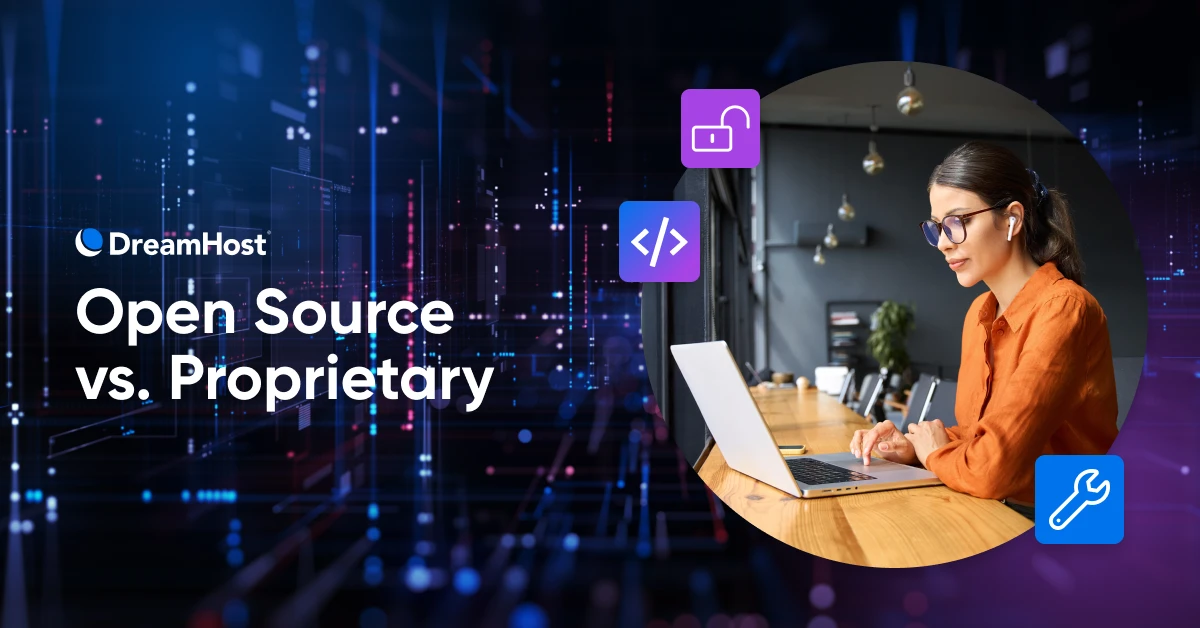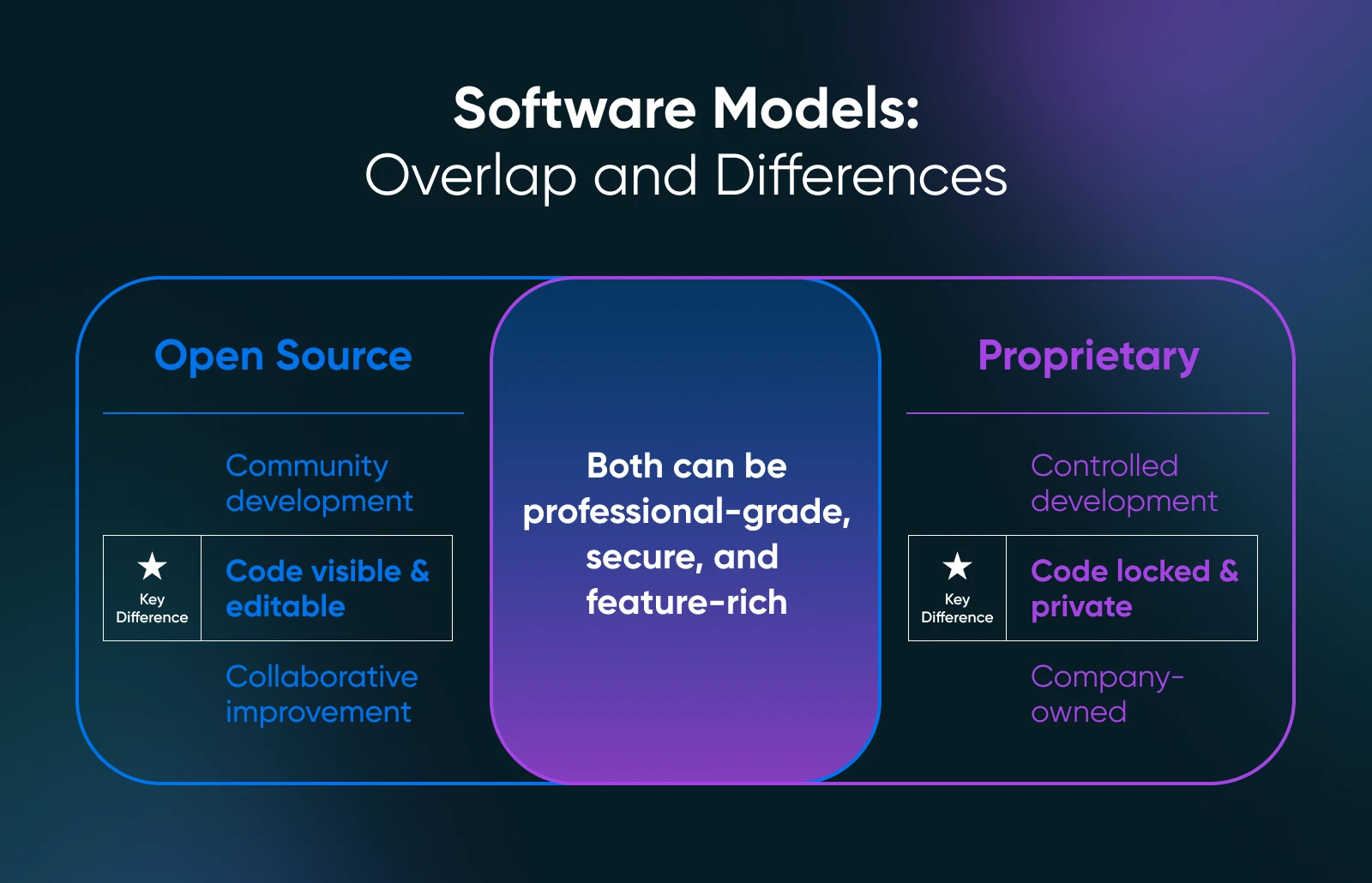Open Source vs. Proprietary: Who’s Driving — You or Your Platform?

Congratulations, you’ve finally pinched enough pennies to ditch walking for good and buy your first car. Now, the fun part: choosing your ride.
Option A: A sleek, self-driving EV that promises to make everything easy peasy — it even parks itself! You pick the color, sign some paperwork, and…that’s about it. You’re driving off into the sunset.
Option B: A rugged, open-top Jeep. It ships with nothing fancy but a wrench set and a world-is-your-oyster set of upgrades. Want a lift kit? A roof-mounted disco ball? A built-in snorkel? If you can dream it (and figure out how to attach it), it’s yours (as long as you’re willing to get your hands greasy, or pay a mechanic).
via GIPHY
Choosing a website platform is a little bit like this, but the stakes aren’t tire rotations and gas mileage; they’re your brand’s future growth, security, and bottom line. Are you cool letting a closed-system vendor handle every oil change, or do you want the keys to the engine bay so you can swap parts whenever inspiration (or necessity)strikes?
That’s the crossroads between open source (like WordPress, the CMS that powers nearly half the internet) and proprietary website builders that bundle the hosting, codebase, and rules into one tidy package.
In this article, we’re not here to tell you which one is better.
Instead, we’re giving you a road atlas that will help guide you through the real-world trade-offs on control, portability, maintenance, and cost that determine whether you should cruise on autopilot or take the wheel when it comes to your business website.
Buckle up, because by the end of this read, you’ll know exactly which lane will get your small business where it needs to go.
What Do “Open Source” and “Proprietary” Actually Mean?
Imagine two kitchens.
In Kitchen 1, every recipe is pinned to a public corkboard. You’re free to tweak grandma’s chili, share your own secret sauce recipe, or invite the whole neighborhood to a potluck. That’s open source software in a nutshell — the underlying code is visible, modifiable, and shareable under licenses that guarantee those freedoms.
In fact, the Open Source Initiative literally codifies that promise in its 10-point Open Source Definition.
Kitchen 2, on the other hand, keeps the cookbook locked in a vault. You can plate the dishes exactly as the chef intended, but any substitutions or even “just a pinch more salt” modifications are strictly prohibited. That’s proprietary software — the publisher owns the code and licenses you a right to use it, but strictly under their terms and conditions.

Why should you care which kitchen to use to cook up your business website? Three main reasons:
1. Ownership and rights
With an open-source site, you can download the codebase, spin up a copy anywhere, and audit every line.
With a proprietary platform, you’re renting access. If the platform shutters, or even just makes a change, like raising its prices, your hands are tied.
But, as one Reddit commenter noted: “Unless you yourself build from sources, you must trust distributor/compiler to use their software.”
The difference is, with open source, that trust is a choice. And the tools to verify, customize, or rebuild are on the table.
2. Community vs. vendor roadmap
With an open-source site, features evolve through global collaboration (think plugins, extensions, language packs, etc., developed by any user for everyone to use).
With a proprietary platform, updates arrive when the vendor ships them. For the best features, you might even have to pay more.
3. Market momentum
One of the biggest open source platforms out there, WordPress, powers around 43% of all websites today, proof that transparency scales.
The bottom line is that there are pros and cons to both approaches. Your need for control (or convenience) will help determine which is a better fit for your needs.
Tinker vs. Plug-and-Play
When it comes to how much control you have over your website, it’s more like a spectrum.
All the way at the open source end, your website can work like a LEGO set: snap on any theme, plugin, or bit of custom code until the end result matches your exact vision.
At the other end of the spectrum, you have plug-and-play website builders, where the platforms do the heavy lifting for you: drag, drop, publish, repeat.
What Maximum Control Looks Like:
What Maximum Convenience Looks Like:
Remember, though: you don’t have to land at either extreme. Many businesses start in plug-and-play mode to validate an idea, then migrate to a more open platform when customization (or cost savings) becomes business critical.
Many businesses live somewhere in the middle of this spectrum… And then stay there long-term.
Portability vs. Locked In
Ever tried switching cellphone carriers and realized your phone is carrier locked? Website platforms can do the same, only the fees are steeper and the downtime hurts your revenue.
Why Portability Matters
Small businesses pivot. Maybe you outgrow a brochure-style site and need a full-blown e-commerce setup, or perhaps you decide to leave a pricey host for greener (read: cheaper) pastures.
Open-source software makes those moves straightforward because the code and data belong to you. You can export your database in open formats (like SQL, XML, or JSON) and spin the site up on virtually any server that supports the same stack.
Closed platforms, on the other hand, often keep their internals under wraps, so migrating means rebuilding templates, rewiring integrations, and hoping the export tool includes more than a zip file of half-formatted content.
The Real Cost of “Just Move Later”
Sticker shock is real when it comes to moving a website.
Industry surveys put a basic website migration in the $300–$5,000 range, while complex sites with custom functionality can soar past $20,000 once you factor in developer hours, SEO retooling, and downtime buffers. Even if your site never hits that upper bracket, knowing that a platform switch can eat an entire quarter’s marketing budget is enough to give any founder pause.

But it isn’t just about the money (although that’s a big part of it). When your data lives in a locked garage, the vendor holds most of the leverage. They can raise prices, retire features, or change terms of service overnight, safe in the knowledge that the exit ramp is lined with time, money, and headaches for you. That’s how being locked into a vendor can result in higher long-term costs, slower innovation, and limited flexibility.
If there’s any chance your business model, traffic volume, or tech stack will change in the next few years —and let’s be honest, it probably will — choose a solution that lets you pack up and hit the road without major costs or headaches.
DIY Maintenance vs. Hands-Off Updates
With an open-source stack such as WordPress, you’re responsible for a regular chore list:
- Core, theme, and plugin updates must be applied promptly: In 2024 alone, the WordPress ecosystem saw nearly 8,000 new disclosed vulnerabilities, most of them in third-party plugins. Neglecting updates leaves the door wide open to attackers.
- Backups, performance monitoring, and uptime checks are on you: If a cache plugin clashes with PHP 8.3 at 2 a.m., your phone (not a vendor help desk) rings first.
- Security hardening and audits never really stop: Tools like firewalls, automated malware scans, and least-privilege user roles need continuous review.
Open-source platforms are flexible, but they also mean you decide when, how, and where work happens. Because of this, many small business owners end up contracting a website maintenance partner instead of learning CLI commands, which comes with an added cost.
Proprietary builders pitch the opposite ownership model: the vendor patches servers, rolls out new features, and (in theory) shields you from late-night crises. Updates are invisible to you (until they aren’t). Even the most stable plug-and-play website builders can experience outages and take their customers offline while users wait for a fix, though this is relatively rare.
So, the choice isn’t really “updates or no updates.” It’s who performs them (you, a hired specialist, or a platform team) and how much control you’re willing to trade for convenience. If you value pixel-perfect freedom and don’t mind budgeting for upkeep, an open-source platform allows you to set your own maintenance schedule.
If you’d rather outsource the entire experience, a proprietary site builder may feel blissfully hands-off, as long as everything runs smoothly like it should.
Sticker Price vs. Total Cost of Ownership
At first glance, proprietary builders often appear to be a steal: a flat subscription that bundles hosting, SSL, and templates for a typically reasonable monthly fee. Entry-level ad-free plans typically hover around $15–$20 per month. But for the best features, you can expect to pay premium prices.
Open source flips the math. The software itself is free, but you become the general contractor:
In your first year, a basic WordPress install (open source) is likely to cost around the same as a mid-tier proprietary plan. Where the numbers diverge is in year two and beyond.
- Scaling costs: Need multilanguage support, complex catalogs, or other advanced features? Open source add-ons usually come with flat licensing fees, while proprietary builders gate the same features behind higher monthly plans that may come with additional perks you don’t need (and price tags to reflect that).
- Cloud “waste”: A 2025 survey found that 27% of cloud spend is wasted, often because teams can’t tune the underlying stack. Open-source owners who control their infrastructure can trim that fat, while proprietary users cannot.
- Exit fees: If you ever migrate away, remember that even a modest rebuild can run in the thousands, with complex migrations costing more. Those costs apply regardless of where you start, but they hit hardest when you’re leaving a closed system that won’t export everything cleanly.
The takeaway: A proprietary platform offers predictable cash flow and low upfront effort, but you pay a risk premium in terms of flexibility and long-term control. Open source starts with à la carte expenses and more DIY, but it rewards the effort with lower incremental costs, richer customization, and the freedom to shop for better deals whenever your traffic — and budget — grows.
Decision Matrix: Which Platform Fits Your Roadmap?
Still torn between an open source or a proprietary platform? Use this matrix to see which better aligns with your needs for control, cash flow, and more.
DreamHost: Open Source Power With Proprietary-Level Support
At DreamHost, we’ve been all-in on open source tech since day one. Open code lets us fine tune infrastructure, contribute patches upstream, and pass the flexibility straight to you. As we like to say, open source isn’t just a tool we use — it’s a value we live by.
But we’re also realistic about the learning curve. If you’d rather not wrestle with cron jobs and cache invalidation at midnight, our managed WordPress and VPS plans add the mechanic to your pit crew: automatic core updates, hardened security, and daily backup, without locking you in a proprietary box. You keep the keys, we just help guide you through keeping the engine purring.

VPS Hosting
We Know You’ve Got Lots of VPS Options
Here’s how DreamHost’s VPS offering stands apart: 24/7 customer support, an intuitive panel, scalable RAM, unlimited bandwidth, unlimited hosting domains, and SSD storage.
Change Your VPS Plan


